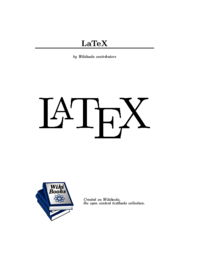Autor "J. M. SMITH"
Se han encontrado 1 Coincidencias
LaTeX
Extensive tutorial on LaTeX typesetting system prepared on Wikibooks
115 Visitas | 136 Descargas | 2014-03-05 19:53:16 | eancedeg
TeX (pronounced “Tech”, with “ch” like in the Scottish “Loch”; see below for de- tails on pronunciation) is a markup language created by Donald Knuth to typeset documents attractively and consistently. It’s also a Turing-complete programming language, in the sense that it supports the if-else construct, it can calculate (the cal- culations are performed while compiling the document), etc., but you would find it very hard to make anything else but typesetting with it. The fine control TeX offers makes it very powerful, but also difficult and time-consuming to use. Knuth started writing the TeX typesetting engine in 1977 to explore the potential of the digital print- ing equipment that was beginning to infiltrate the publishing industry at that time, especially in the hope that he could reverse the trend of deteriorating typographical quality that he saw affecting his own books and articles. TeX as we use it today was released in 1982, with some slight enhancements added in 1989 to better support 8-bit characters and multiple languages. TeX is renowned for being extremely stable, for running on many different kinds of computers, and for being virtually bug free.
Contribuir
Usted puede contribuir con Libros UCLV, es importante para nosotros su aporte..
Contribuir